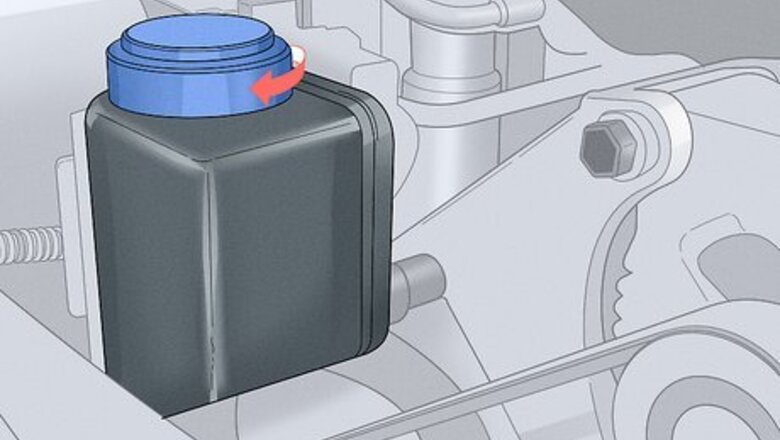
views
Checking and Filling the System
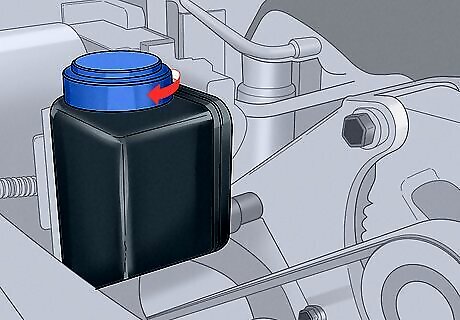
Locate the power steering reservoir and twist the cap off. Read your vehicle’s manual to find your power steering reservoir, which is where the power steering fluid is stored. The location of this tank varies from vehicle to vehicle, but it’s usually next to the coolant reservoir on the passenger side of the engine bay. Look for a small, cylindrical compartment that looks roughly half the size of the coolant reservoir and has a removable plastic cap on top. With the vehicle off, twist the cap off of the power steering reservoir by twisting it counterclockwise. It will usually say “power steering” on top of the plastic cap. It may also list the type of power steering fluid you need on the cap. This is one of those automotive repairs that basically anyone can do, especially since you don’t need to remove or disassemble anything. This is a great way to save a few dollars by skipping a trip to the mechanic!
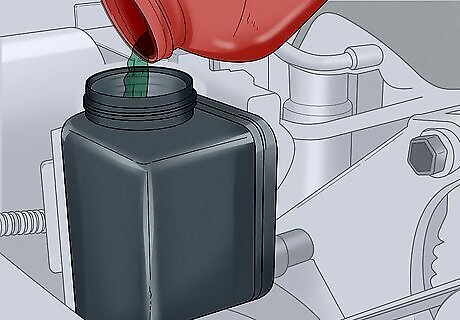
Fill the power steering reservoir to the cold fill line if the fluid is low. You can determine what type of power steering fluid you need by reading your instruction manual. It is usually printed on the reservoir cap as well. Inspect the dipstick attached to the bottom of the cap. There are two hash marks: cold, and hot. If the liquid is lower than the “cold” hash mark, slide a funnel into the reservoir’s opening and pour in enough power steering fluid to reach the “cold” hash mark on the dipstick. Most vehicles use Dextron, Pentosin, or synthetic hydraulic fluid. You can purchase power steering fluid at any automotive store. If your reservoir doesn’t have a dipstick, there’s a fill line on the inside or outside of the reservoir. You may need to use a flashlight to look inside the tank and look for the fill line.
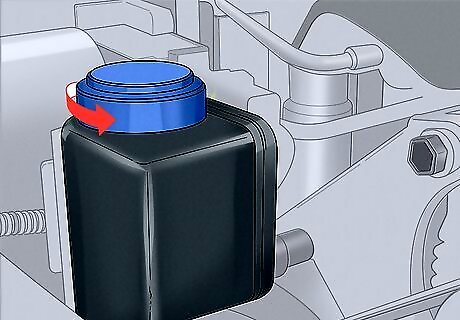
Close the cap to keep fluid from popping out while you bleed the system. Bleeding the power steering lines forces air out of the system. This can cause power steering fluid to spill out of the reservoir as the pressure in the power steering lines increases. To avoid making a mess, put the cap back on your power steering reservoir and close it tight. Once your vehicle is off of the ground, you can slide a drip pan under the reservoir just to be safe. This is probably unnecessary, but it’s a good idea if you want to keep steering fluid off of the ground.
Removing the Air
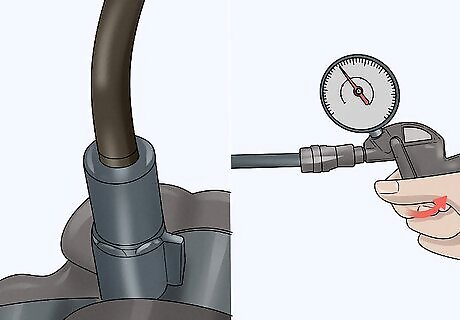
Bleed the system using a vacuum pump kit if your car has a bleed valve. Read your vehicle’s manual to see if your power steering has a bleed valve. If it does, purchase a vacuum pump kit for a power steering system and slide the end of the vacuum pump’s hose over the bleed valve. Then, pull the trigger on the vacuum until the gauge on the pump reads 20 Hg (inches of mercury). This will pull any excess air out of the system. A small percentage of vehicles have bleed valves on the power steering assembly. Most vehicles don’t come with one because it’s fairly easy to bleed the power steering without a vacuum kit. You can buy a reservoir cap with a bleed valve adaptor on the lid if you want to use a vacuum kit to pump your power steering lines but you don’t have a built-in bleed valve. You can also buy a vacuum kit with an adaptor that slides directly into the opening of the reservoir if you don’t want to buy a new cap. You can still bleed your power steering using the traditional method if you have a bleed valve. This is just an option you have if your vehicle comes with a bleed valve. It’s easier to do it this way since you don’t need to elevate the vehicle and it takes less than 5 minutes. You don’t need to open or close anything to insert the hose into the bleed valve. The hose just slides right on.
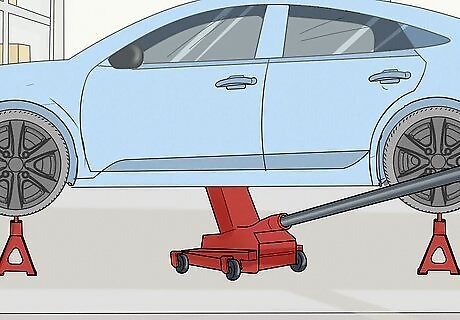
Lift your vehicle off of the ground with jack stands. With your vehicle on a flat surface, slide wedges or chocks behind your back tires to keep the vehicle from sliding back. Slide a hydraulic floor jack under one side of your vehicle. Step repeatedly on the hydraulic jack’s pedal to raise the side of your vehicle up. Then, slide a jack stand under the side of the vehicle so it rests on the frame. Repeat this process on the other side to lift your front wheels entirely off of the ground. If you can, use the smallest jack stands available to you. You only need the tires to be slightly off the ground, and it’ll be easier and safer to get in and out of the vehicle if you don’t have to climb up to get in the driver’s seat. You don’t need to raise the back. Bleeding the power steering involves turning the steering wheel back and forth over and over again. You only need the front wheels off of the ground. If you don’t have jack stands, you can still do this with your vehicle on the ground. You may not completely bleed the power steering lines, but you should still see a noticeable improvement if there is air trapped in the system.
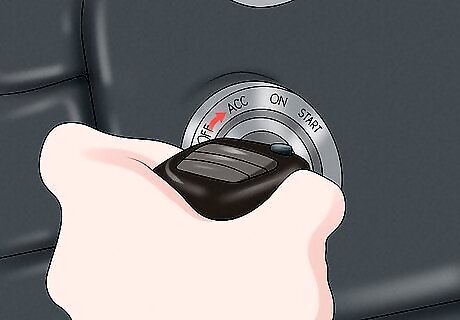
Put the key in the ignition to unlock the steering wheel. Carefully get in the vehicle, or open the door and reach over to the ignition. Insert the key in the ignition, but don’t turn the vehicle on. You need to turn the steering wheel while the vehicle is off, but you can’t do this if the key isn’t in the ignition. On some vehicles, you’ll need to turn the key to the accessory position by turning it halfway or backward to unlock the steering wheel. It all depends on your make and model.
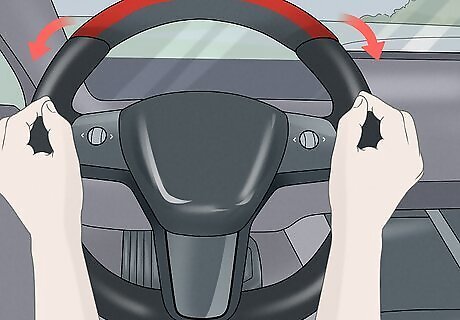
Turn the steering wheel lock to lock by turning it left and right. Grab your steering wheel and turn it all the way to the left like you’re making an extreme left turn. Once the wheels rotate as far as they can to the left, turn the steering wheel all the way to the right. This is known as turning the steering wheel from lock to lock, and this process forces air out of your power steering pump and lines. Turning your steering wheel engages the power steering and forces the fluid to cycle through the lines. If there is air trapped in your power steering lines, this pressure forces the air out to the top of the reservoir.
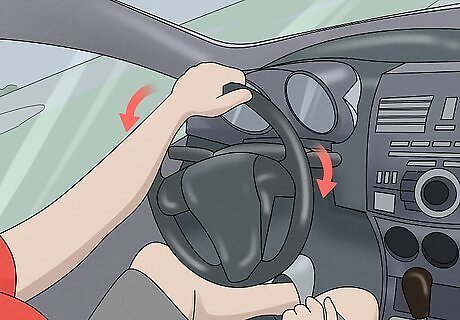
Keep turning the steering wheel 20 or 35 more times to push the air out. Continue turning the steering wheel back and forth. Go all the way to the left, then all the way to the right. If you drive a standard car, do this at least 20 times to force all of the air out. Do this 35 times if you drive an SUV, truck, or minivan.
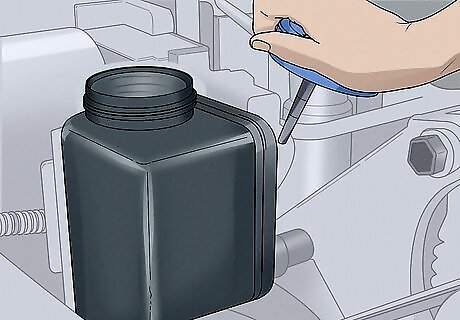
Check the power steering level after turning the wheel and fill as needed. Get out of the vehicle carefully and walk back over to the power steering reservoir. Open the cap on your reservoir and check the power steering fluid to see if it is lower than it was when you first checked it. If it is low, fill the power steering reservoir up with more power steering fluid so that the liquid reaches the “cold” fill line on the dipstick. The power steering fluid levels typically go down when you remove the air. The excess air sits in the power steering lines and pushes the fluid up to make it seem like there is more fluid in the power steering lines than there actually is. Removing this air will cause the fluid levels to drop back down. You may hear a small popping sound when you open the cap. This is because all of the air was forced to the top of the reservoir when you were turning lock to lock.
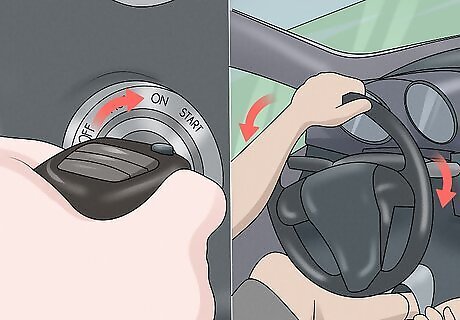
Start the vehicle and turn the steering wheel lock to lock 20 or 35 times. Close the cap on the power steering reservoir and get back in the vehicle. Start your vehicle. Then, turn the wheel lock to lock again by turning the wheel all the way to the left, then all the way to the right. If you drive a standard car, do this an additional 20 times to let the power steering fluid cycle through the lines again. If you have an SUV, truck, or minivan, do this 35 times. If you notice the steering is smoother while you’re doing this, congratulations! You likely removed all of the air and you’re about to be done.
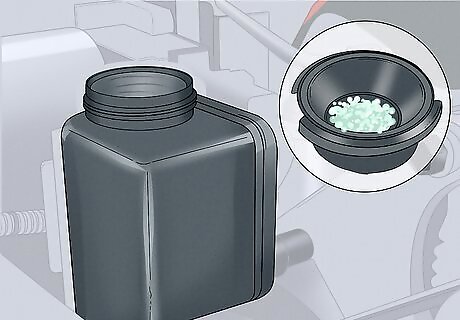
Inspect the top of the power steering reservoir for bubbles. Turn the engine off and get out of the vehicle again. Go to your power steering reservoir and open the cap. If you see the fluid at the top of the reservoir bubbling, it means there is still some air in your power steering lines. If there is no bubbling, the air is gone and you’re done! If all of the air is gone and there is no more bubbling, close the cap on your power steering reservoir and take your jack stands off.
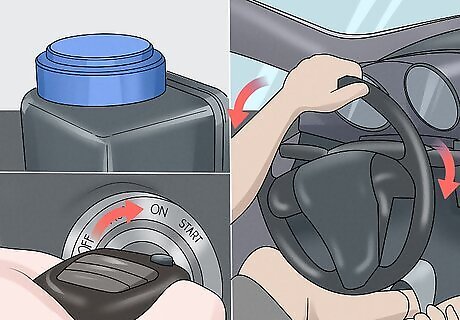
Continue turning the steering wheel until the fluid is bubble-free. If you saw bubbling in the power steering reservoir, close the cap and get back in the vehicle. Turn the engine on and turn it lock to lock an additional 20-30 times. Continue repeating this process until you no longer see bubbles appearing at the top of the power steering reservoir. When you’re done, tighten the cap on the reservoir and take your vehicle off of the jack stands.




















Comments
0 comment